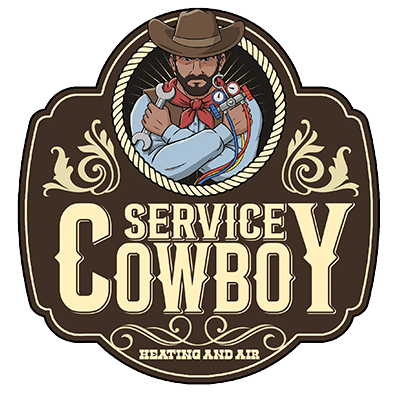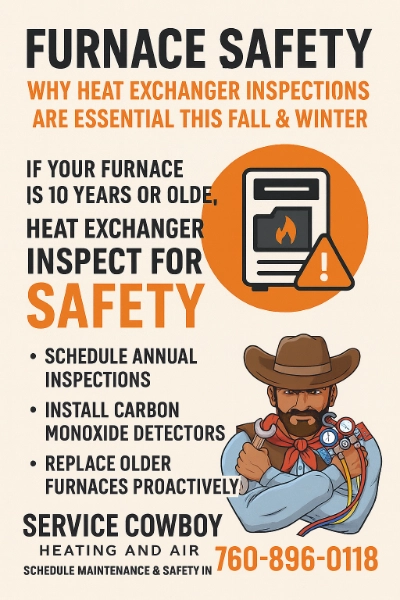Protect Your Family: How to Test and Maintain Carbon Monoxide Detectors

Carbon monoxide (CO) is an odorless, colorless gas that can be deadly. Because you can't see, smell, or taste it, CO can poison you without you even knowing. That's why carbon monoxide detectors are essential safety devices for every home. But simply having a detector isn't enough; you need to know how to properly test and maintain it to ensure it's working correctly. Protect your family by following these vital steps.
If you're in the San Diego area and need assistance with your heating system or carbon monoxide detectors, don't hesitate to call Service Cowboy Heating and Air at (760) 896-0118 for expert service you can trust.
Understanding Carbon Monoxide and Its Dangers
Carbon monoxide is produced by the incomplete burning of fuels such as natural gas, propane, oil, wood, and even gasoline. Common sources in the home include:
- Furnaces
- Water heaters
- Fireplaces
- Gas stoves
- Generators
- Vehicles running in attached garages
When inhaled, CO replaces oxygen in your bloodstream, leading to serious health problems and even death. Symptoms of CO poisoning can be flu-like and easily mistaken for other illnesses, including:
- Headache
- Dizziness
- Weakness
- Nausea
- Vomiting
- Chest pain
- Confusion
Prolonged exposure can lead to loss of consciousness, brain damage, and death. Children, pregnant women, and people with heart or respiratory conditions are particularly vulnerable.
Choosing the Right Carbon Monoxide Detectors
Not all carbon monoxide detectors are created equal. Consider these factors when choosing detectors for your home:
- Type: There are two main types of CO detectors:
- Electrochemical sensors: These are generally more accurate and have a longer lifespan (5-10 years).
- Biomimetic sensors: These use a gel that changes color when exposed to CO. They typically have a shorter lifespan (2-5 years).
- Power source:
- Battery-powered: These are easy to install but require regular battery changes.
- Hardwired with battery backup: These offer the most reliable protection, as they work even during power outages.
- Plug-in with battery backup: These are a good compromise, offering both convenience and reliability.
- Features: Some detectors offer additional features, such as:
- Digital display: Shows the CO level in parts per million (ppm).
- Voice alarm: Provides clear audible warnings.
- End-of-life warning: Alerts you when the detector needs to be replaced.
Look for detectors that meet the UL 2034 standard, which ensures they meet specific performance and safety requirements.
Proper Placement of Carbon Monoxide Detectors
The placement of your CO detectors is crucial for early detection. Follow these guidelines:
- Install CO detectors on every level of your home, including the basement.
- Place detectors outside each sleeping area, within 10 feet of bedroom doors.
- For optimal protection, install a detector inside each bedroom.
- Avoid placing detectors near fuel-burning appliances, as brief CO releases can trigger false alarms. However, do place one close enough to alert you to malfunctions.
- Do not place detectors in dusty, dirty, or humid areas, as these conditions can affect their performance.
- Avoid placing detectors near windows or doors, where drafts can dilute the CO and delay detection.
- Mount detectors on the wall about 5 feet above the floor.
Testing Your Carbon Monoxide Detectors
Testing your CO detectors regularly is essential to ensure they are functioning correctly. Here's how:
- Test weekly or monthly: Press the "test" button on the detector. The alarm should sound if it's working properly.
- If the alarm doesn't sound: Replace the batteries immediately and test again. If it still doesn't work, replace the detector.
- Listen for the alarm: Make sure everyone in the household knows what the CO alarm sounds like.
Maintaining Your Carbon Monoxide Detectors
Proper maintenance will extend the life of your CO detectors and ensure their reliability:
- Replace batteries: Replace the batteries in battery-powered detectors at least every six months, or when the low-battery warning sounds. A good practice is to replace them when you change your clocks for daylight saving time.
- Clean detectors: Dust or vacuum the detectors regularly to remove dirt and debris that can clog the sensors.
- Never paint over detectors: Painting can damage the sensors and prevent them from working properly.
- Replace detectors: CO detectors have a limited lifespan. Replace them according to the manufacturer's instructions, typically every 5-10 years. Note the expiration date when installing.
What to Do If Your Carbon Monoxide Detector Goes Off
If your CO detector sounds, it's crucial to act quickly and calmly:
- Evacuate immediately: Get everyone out of the house and into fresh air.
- Call emergency services: From a safe location, call 911 or your local fire department.
- Do not re-enter: Do not go back inside the house until emergency personnel have determined it is safe to do so.
- Get medical attention: Seek medical attention for anyone who may have been exposed to CO, even if they don't have symptoms.
- Identify the source: Once the house is safe, have a qualified technician inspect your fuel-burning appliances to identify and repair the source of the CO leak. Service Cowboy Heating and Air in San Diego can help with this.
Professional Heating System Maintenance
Regular maintenance of your heating system is crucial for preventing CO leaks. Service Cowboy Heating and Air offers comprehensive heating services, including:
- Furnace tune-ups: Inspecting and cleaning the furnace to ensure it's operating efficiently and safely. According to Service Cowboy, a tune-up includes "inspecting the heat exchanger, cleaning burners, checking gas pressure, calibrating the thermostat, and ensuring safe efficient operation."
- Carbon monoxide testing: Checking for CO leaks and ensuring proper ventilation.
- Heating system repairs: Addressing any issues that could lead to CO buildup. They offer same-day diagnostics with full system checks and upfront pricing with no hidden fees.
- Furnace installation and replacement: Replacing outdated or malfunctioning furnaces with energy-efficient models.
By investing in professional heating system maintenance, you can protect your family from the dangers of carbon monoxide and ensure your home is warm and comfortable all winter long.
Don't wait until it's too late! Call Service Cowboy Heating and Air today at (760) 896-0118 to schedule a heating system inspection or carbon monoxide detector installation in the San Diego area.
Need Heating Services in San Diego County?
Service Cowboy Heating and Air provides honest, dependable, and personalized HVAC solutions throughout San Diego County. From coastal La Jolla to inland Poway, their expert technicians provide lasting repairs, efficient installations, and thorough maintenance.
Contact Service Cowboy Today!Call or Text (760) 896-0118
About the Author: John Weber is a certified HVAC professional with over 15 years of experience in the heating and air conditioning industry. He founded Service Cowboy Heating and Air to provide reliable and honest HVAC services to the San Diego community. John is committed to ensuring the safety and comfort of his customers' homes through expert heating system maintenance and carbon monoxide detection services.

